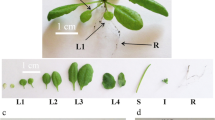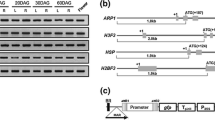Abstract
The CaMV 35S promoter is the most commonly used promoter for driving transgene expression in plants. Though it is presumed to be a constitutive promoter, some reports suggest that it is not expressed in all cell types. In addition, the information available on its expression profile in all possible cell and tissue types and during early stages of development is incomplete. We present here a detailed expression profile of this promoter investigated using the green fluorescent protein (GFP) gene as a reporter system in cotton during embryo development, and in all the vegetative and floral cell and tissue types. GFP expression was not detected during the early stages of embryogenesis. The first perceptible GFP expression was observed in a small area at the junction of hypocotyl and cotyledons in embryos at around 13 days after anthesis. The GFP fluorescence progressively became stronger and expanded throughout the cotyledon and hypocotyl as embryo development advanced. After germination, varying levels of promoter activity were observed in all cell and tissue types in the hypocotyl, cotyledon, stem, leaf, petiole, and root. The promoter was also expressed in all floral parts. Although cotton pollen exhibited a low level of greenish autofluorescence, it was possible to discern GFP-dependent fluorescence in some of the pollen from all the T0 plants examined. Developing cotton fibers also exhibited GFP fluorescence suggesting that the 35S promoter was active in these specialized epidermal cells. Thus, we show that the expression of the 35S promoter was developmentally regulated during embryogenesis and that beyond a certain stage during embryogenesis, the promoter was expressed in most cell and tissue types in cotton albeit at different levels.
Similar content being viewed by others
References
Assad-Garcia, N., Ochoa-Alejo, N., Garcia-Hernandez, E., Herrera-Estrella, L. and Simpson, J. 1992. Agrobacterium-mediated transformation of tomatillo (Physalis ixocarpa) and tissue specific and developmental expression of the CaMV 35S promoter in transgenic tomatillo plants. Plant Cell Rep. 11: 558–562.
Battraw, M.J. and Hall, T.C. 1990. Histochemical analysis of CaMV 35S promoter-?-glucuronidase gene expression in transgenic rice plants. Plant Mol. Biol. 15: 527–538.
Benfey, P.N. and Chua, N.-H. 1989. Regulated genes in transgenic plants. Science 244: 174–181.
Benfey, P.N., Ren, L. and Chua, N.-H. 1989. The CaMV 35S enhancer contains at least two domains which can confer different developmental and tissue-specific expression patterns. EMBO J. 8: 2195–2202.
Benfey, P.N., Ren, L. and Chua, N.-H. 1990a. Tissue specific expression from CaMV 35S enhancer subdomains in early stages of plant development. EMBO J. 9: 1677–1684.
Benfey, P.N., Ren, L. and Chua, N.-H. 1990b. Combinatorial and synergistic properties of CaMV 35S enhancer subdomains. EMBO J. 9: 1685–1696.
Chalfie, M., Tu, Y., Euskirchen, G., Ward, W.W. and Prasher, D.C. 1994. Green fluorescent protein as a marker for gene expression. Science 263: 802–805.
Chiu, W.L., Niwa, Y., Zeng, W., Hirano, T., Kobayashi, H. and Sheen, J. 1996. Engineered GFP as a vital reporter in plants. Curr. Biol. 6: 325–330.
Custers, J.B.M., Snepvangers, S.C.H.J., Jansen, H.J., Zhang, L. and van Lookeren Campagne, M.M. 1999. The 35S-CaMV promoter is silent during early embryogenesis but activated during nonembryogenic sporophytic development in microspore culture. Protoplasma 208: 257–264.
Greenplate, J.T., Head, G.P., Penn, S.R. and Kabuye, V.T. 1998. Factors potentially influencing the survival of Helicoverpa zea on Bollgard cotton. In: P. Dugger and D. Richter (Eds) Proceedings of the Beltwide Cotton Conferences (5-9 January 1998, San Diego, CA), vol. 2, National Cotton Council of America, Memphis, TN, p. 1030.
Guerrero, F.D., Crossland, L., Smutzer, G.S., Hamilton, D.A. and Mascarenhas, J.P. 1990. Promoter sequences from a maize pollen-specific gene direct tissue-specific transcription in tobacco. Mol. Gen. Genet. 224: 161–168.
Harter, C. and Wieland, F. 1996. The secretory pathway: mechanisms of protein sorting and transport. Biochim. Biophys. Acta 1286: 75–93.
Haseloff, J. and Amos, B. 1995. GFP in plants. Trends Genet. 11: 328–329.
Haseloff, J., Siemering, K.R., Prasher, D.C. and Hodge, S. 1997. Removal of cryptic intron and subcellular localization of green fluorescent protein are required to mark transgenic Arabidopsis plants brightly. Proc. Natl. Acad. Sci. USA 94: 2122–2127.
Jefferson, R.A., Kavanagh, T.A. and Bevan, M.W. 1987. GUS fusions: ?-glucuronidase as a sensitive and versatile gene fusion marker in higher plants. EMBO J. 6: 3901–3907.
Mascarenhas, J.P. and Hamilton, D.A. 1992. Artifacts in the localization of GUS activity in anthers of petunia transformed with a CaMV 35S-GUS construct. Plant J. 2: 405–408.
McCabe, D.E. and Martinell, B.J. 1993. Transformation of elite cotton cultivars via particle bombardment of meristems. Bio/technology 11: 596–598.
Odell, J.T., Nagy, F. and Chua, N.-H. 1985. Identification of DNA sequences required for activity of the cauliflower mosaic virus 35S promoter. Nature 313: 810–812.
Pelham, H.R.B. 1989. Heat shock and the sorting of luminal ER proteins. EMBO J. 8: 3171–3176.
Perlak, F.J., Deaton, R.W., Armstrong, T.A., Fuchs, R.L., Sims, S.R., Greenplate, J.T. and Fischoff, D.A. 1990. Insect resistant cotton plants. Bio/technology 8: 939–943.
Rouwendal, G.J.A., Mendes, O., Wolbert, E.J.H. and de Boer, A.D. 1997. Enhanced expression in tobacco of the gene encoding green fluorescent protein by modification of its codon usage. Plant Mol. Biol. 33: 989–999.
Siemering, K.R., Golbik, R., Sever, R. and Haseloff, J. 1996. Mutations that suppress the thermosensitivity of green fluorescent protein. Curr. Biol. 6: 1653–1663.
Sunilkumar, G. and Rathore, K.S. 2001. Transgenic cotton: factors influencing Agrobacterium-mediated transformation and regeneration. Mol. Breed. 8: 37–52.
Terada, R. and Shimamoto, K. 1990. Expression of CaMV 35SGUS gene in transgenic rice plants. Mol. Gen. Genet. 220: 389–392.
Wang, S. and Hazelrigg, T. 1994. Implications for bcd mRNA localization from spatial distribution of exu protein in Drosophila oogenesis. Nature 369: 400–403.
Wilkinson, J.E., Twell, D. and Lindsey, K. 1997. Activities of CaMV 35S and nos promoters in pollen: implications for field release of transgenic plants. J. Exp. Bot. 48: 265–275.
Williamson, J.D., Hirsch-Wyncott, M.E., Larkins, B.A. and Gelvin, S.B. 1989. Differential accumulation of a transcript driven by the CaMV 35S promoter in transgenic tobacco. Plant Physiol. 90: 1570–1576.
Yang, N.-S. and Christou, P. 1990. Cell type specific expression of a CaMV 35S-GUS gene in transgenic soybean plants. Dev. Genet. 11: 289–293.
Author information
Authors and Affiliations
Rights and permissions
About this article
Cite this article
Sunilkumar, G., Mohr, L., Lopata-Finch, E. et al. Developmental and tissue-specific expression of CaMV 35S promoter in cotton as revealed by GFP. Plant Mol Biol 50, 463–479 (2002). https://doi.org/10.1023/A:1019832123444
Issue Date:
DOI: https://doi.org/10.1023/A:1019832123444




